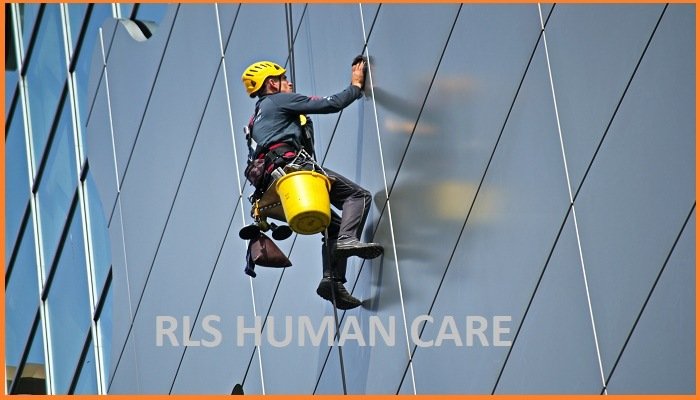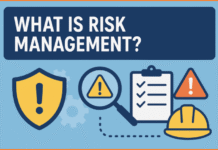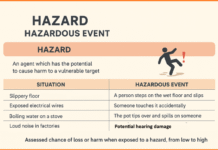Contents
Hazard associated with work at height
The greatest hazard at the work at height because serious or severe accidents occur due to fall of person from working at height.
The work at height involves the following hazards…
Fall of person from elevated working platform, Fall of object/materials/tools in to the persons below on the ground, Contact with overhead services such as naked electrical wire.Equipment failure.
Every employer should ensure that work at height is properly planned.
Planning of work includes planning for emergencies and rescue.Make sure communication is maintained at all the time.
CLICK HERE FOR ? LADDER SAFETY TOOL-BOX-TALK
It is also essential to ensure that the persons doing the job at height are sound in health and do not suffer from vertigo or any other phobia of working at height.
Make sure that you are at safe place and then concentrate on job.Maintain high stranded of house keeping because must of the slips and falls are caused by poor house keeping.Platform should be always free from tools and debris.
Should not be allowed to work at height during storm and high winds.Site should be properly illuminated, workers should not be allowed to work at height during poor illumination.
WORKING AT HEIGHT
Most of the fall accidents happen while at height and most of them prove fatal. Therefore the seriousness of fall accidents should be considered seriously.
Incidence and Seriousness of Fall Accidents
People are subjected to two types of falls, fall, and physical fall. Both are serious and need prevention for the safe elevation of life.
Accidents to ethical falls spoil the self, as well as the society, are much more in number than the physical fall generally affect the person concerned only.
This comparison and we are, here, concerned with a range of physical industrial falls only.
CLICK HERE FOR ? MAN LIFT SAFETY TOOL-BOX-TALK
Common Cause of Fall from Height

- Water, oil or grease not cleaned up.
- Loose, defective or broken floor or toe board.
- Scrap, chipping, tripping and obstructions material lying on the way.
- Dusty, steamy or smoky atmosphere restricting vision.
- Carrying too much load making it difficult to see over the load.
- Worn out or unsuitable footwear.
- Poor lighting, glare or shadows.
- Rushing instead of walking.
- Defective or weak scaffolds.
- Ladders, ramps, planks, and platforms not rigid or safe for the job.
- No or inadequate handrails.
- Climbing oddly instead of using a ladder.
- Throwing instead of lowering tools or materials while working aloft.
- Not using spectacles for clear vision.
- Not using the crawling board on a fragile roof.
- Not using a full-body safety harness or using it in a wrong way, e.g. not tying its free-end or tying it with weak support.
- Not closing the manhole cover or floor opening etc.
- Allowing roof work and floor work at a time in the same vertical plane.
- Touching of crane boom, hook, etc. to the weak or unfastened structure.
- Non-compliance of statutory provisions.
Most of the fills from height prove fatal or result in a serious fracture. ‘therefore their prevention or control is of utmost necessity.
Control Measures for Fall Accidents:
- Safe, sound and dry (non-slippery) surfaces for walking and working. Fencing, guarding and toe boards.
- PPE’s – Full body harness, Antiskid safety shoes and all mandatory PPE’s.
- Safety practice in walking and working. No excessive load lifting.
- Safe access while working at height or depth.
- Use of crawling board, cat ladder fall arrester, safety net, etc. while working on a fragile roof.
- Use of Safety work permit for working at height or depth.
- Safe and sound stairs, ladders, scaffold, etc and safe use, therefore.
- Good lighting and proper supervision, cutting off the power supply in overhead electric lines.
- Safe cordon to disallow person in the area where an object may fall from height.
- Proper work at height training given to workers as well as staff.
- Work at height safety poster display at the working location.
- Only trained and qualified workers allow for working at height.
- Medical examination of workers (vertigo test).
- Removal of all causes mentioned above.
Safety requirements while working at Height
Fall happens due to falling from the stairway runs ramps, gangways, floors, and ladders. Therefore aspects of their design, construction, and use are explained below:
Stairways:
The slope of a stairway should be 30 °. The tread width should not be less than 24 cm plus a non-slip nosing of 2.5 cm.
The riser should not be more than 20 cm and should be constant for each flight. All stairways should be fitted with railings on the open side handrails on sides which are otherwise enclosed height of the railings at the stairs should be n than 75 cm or more than 90 cm measured from t surface of the stair tread.
The stair landings should be protected by railings and toe-boards. Non-skid on stair treads can prevent slipping. Adequate lighting on the stairway should be provided to avoid accidents.
CLICK HERE FOR ? HIRA AND JSA

Two formula are quoted in ILO literature
Where d is the depth of the step, h is the height of the riser, n the number of steps and ‘l’ the length of the landing. Recommendation for h is 16 to 20 cm, then ‘d’ should be 30 cm. The width of the staircase should be more than 75 cm. Instead of continuous steps, groups of 5 to 6 steps should be preferred.
Ramps, Runways, and Gangways:
The slope ramps, runways, gangways, etc. should be as small as possible and the recommended maximum is 150 to the horizontal.
Cleats not more than 40 cm apart, should be provided on-ramps with steep slopes. Toe-board. should be provided where a ramp extends over a workplace or a passage. Wire screen is necessary on the sides if there is a risk of materials falling through the sides.
CLICK HERE FOR ? SWL-SAFE WORKING LOAD AND SAFETY FACTOR
Runways are long with the uniform slope as they are at arodram.
Floors and Platforms:
The design should consider all types of load in the form of materials, persons and other forces acting on the floor.
Acid proof bricks laid in acid-resistant plaster should be the choice of flooring for a workroom in which acids are handled. Unprotected floor edges situated at the heights and openings, sumps, pits, etc., in platforms or floors should be protected by railings, toe-boards or guards. The height of the railings from the base should be not less than 90 cm or more than 120 cm. It should have intermediate members to shorten the gap of less than 47 cm. The toe-board should not be less than 15 cm in height.
Floors should be of sufficient strength and shall never be overloaded. They should be non-slippery, free from holes, openings, pinch points, uneven surfaces, irregularities, accumulation of oil, water, waste, dust, etc. Near wet process and water showers, proper drainage should be provided.
Open gutters, curbs, and floor openings (holes, chutes, inspection plates) must be fenced or guarded to protect unwarily persons or prevent material falling through it to the floor below.
The non-conductive floor in the explosive atmosphere poses a special hazard. Discharge of static electricity generates the spark which can ignite the explosive mixture near the floor.
Therefore steel tipped or nailed boots or dropping of steel tools on such floor is hazardous. Such floors must be earthed properly.
In industry, criteria for floor selection are many. In addition to strength, comfort and cost, resistance to
- wear and abrasion
- chemicals
- fire
- environmental factors
- the material in the process is also to be considered.
Floors are also of many types. Acids and alkali should be avoided on concrete, granolithic, linoleum, magnesite, quarry tile, ceramic, wood and terrazzo type floor.
Solvents and oils should be avoided on rubber, thermoplastic, vinyl and vinyl asbestos floor. The cleaning process should not damage the floor affecting its strength or anti-slip properties. Cleaners like soaps, natural detergents, alkaline solution, abrasive powder, and damp floor cloths should be used.
The slope is an important factor in floor design. 1 to 2 % gradient towards drain helps ensure to flow away water and keep the surface dry.
People also search for:
- work at height safety procedure
- work at height safety ppt
- working at height safety toolbox talk
- working at height toolbox talk presentation
- working at height control measures
- fall hazard control measures
- work at height hazards list







Hi can you please share which documents are required for the height work activity?